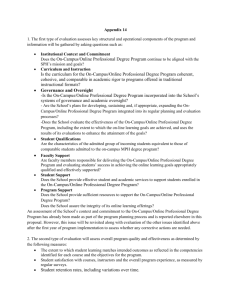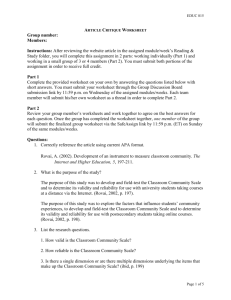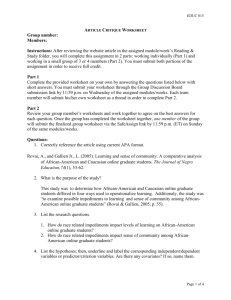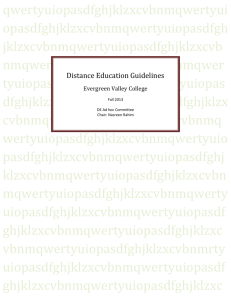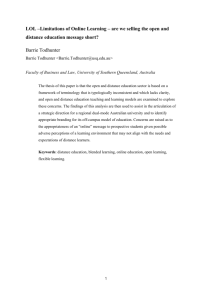EDUC 815 Article Critique Worksheet Group number: Members
advertisement
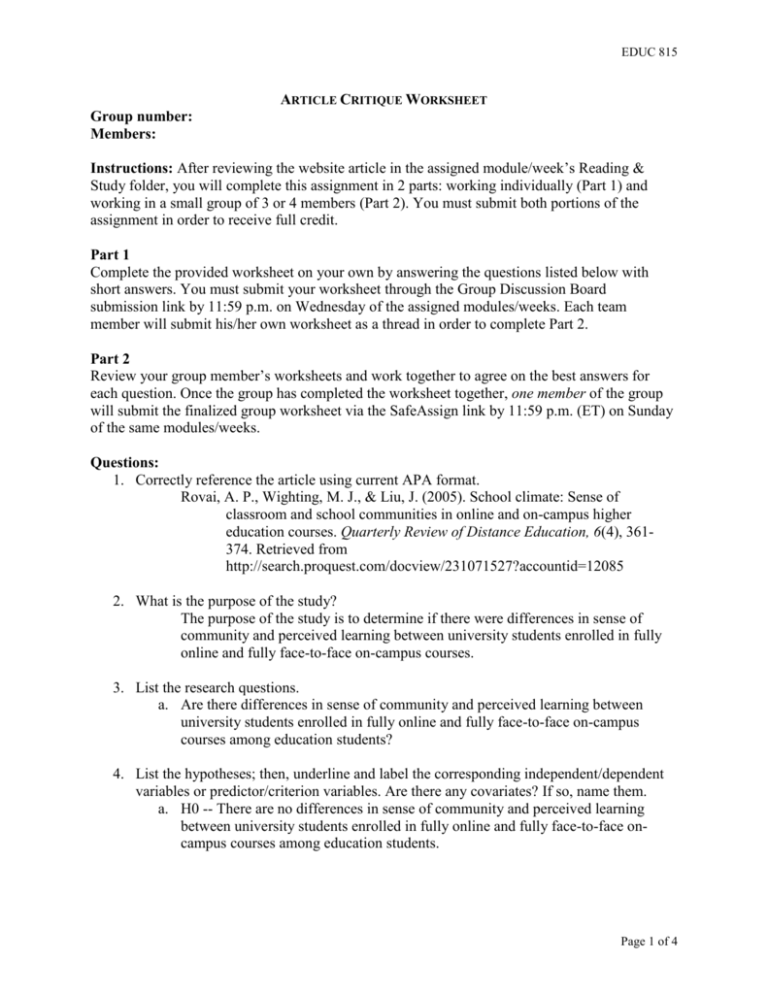
EDUC 815 ARTICLE CRITIQUE WORKSHEET Group number: Members: Instructions: After reviewing the website article in the assigned module/week’s Reading & Study folder, you will complete this assignment in 2 parts: working individually (Part 1) and working in a small group of 3 or 4 members (Part 2). You must submit both portions of the assignment in order to receive full credit. Part 1 Complete the provided worksheet on your own by answering the questions listed below with short answers. You must submit your worksheet through the Group Discussion Board submission link by 11:59 p.m. on Wednesday of the assigned modules/weeks. Each team member will submit his/her own worksheet as a thread in order to complete Part 2. Part 2 Review your group member’s worksheets and work together to agree on the best answers for each question. Once the group has completed the worksheet together, one member of the group will submit the finalized group worksheet via the SafeAssign link by 11:59 p.m. (ET) on Sunday of the same modules/weeks. Questions: 1. Correctly reference the article using current APA format. Rovai, A. P., Wighting, M. J., & Liu, J. (2005). School climate: Sense of classroom and school communities in online and on-campus higher education courses. Quarterly Review of Distance Education, 6(4), 361374. Retrieved from http://search.proquest.com/docview/231071527?accountid=12085 2. What is the purpose of the study? The purpose of the study is to determine if there were differences in sense of community and perceived learning between university students enrolled in fully online and fully face-to-face on-campus courses. 3. List the research questions. a. Are there differences in sense of community and perceived learning between university students enrolled in fully online and fully face-to-face on-campus courses among education students? 4. List the hypotheses; then, underline and label the corresponding independent/dependent variables or predictor/criterion variables. Are there any covariates? If so, name them. a. H0 -- There are no differences in sense of community and perceived learning between university students enrolled in fully online and fully face-to-face oncampus courses among education students. Page 1 of 4 EDUC 815 b. H1 – There are differences in sense of community and perceived learning between university students enrolled in fully online and fully face-to-face on-campus courses among education students. 5. Do the questions pose an ethical or moral problem for implementation? Why or why not? The questions do not pose and ethical or moral problem for implementation. Students, as a class, tend to be more experimental in nature. Education students, as a class, tend to be more willing to learn for the sake of learning. As such, students likely to be questioned in this study would be forthcoming with honest answers to validate the scale provided. Personal information was appropriately removed, and students were allowed to remain anonymous. 6. Do the questions or hypotheses measure any theoretical constructs? If so, list them. The hypothesis implies a theoretical construct that there is no difference in sense of community and perceived learning between university students enrolled in fully online and fully fac-to-face on-campus courses among education students. “The Classroom and School Community Inventory (CSCI; Rovai, Wighting, & Lucking, 2004) was used to measure classroom community and school community” (Rovai, Wighting, & Liu, 2005, p. 366). 7. Do the author(s) clearly identify the participants and setting? If so, describe them. The study clearly identified the participants and setting as follows: Participants: 279 university students enrolled in undergraduate and graduate education programs. The volunteer rate for this study was 83.30%. The sample consisted of 250 (89.6%) females and 29 (10.4%) males. A total of 195 (69.9%) participants were Caucasian, 55 (19.7%) were African American, 6 (2.2%) were Asian/Pacific Islander, 4 (1.4%) were Hispanic, and 19 (6.8%) classified themselves as other; 104 (37.3%) were undergraduates and 175 (62.7%) were graduate students. All undergraduate students were preparing for careers in education All graduate students were employed in the field of education the majority working in the K-12 school environment. 8. What research design is used and why? A quantitative approach was used to allow for statistical analysis of the results. Multivariate Analysis of Variances (MANOVAs) were used to analyze. 9. What type of sampling method is used? The present study used a convenience sample of undergraduate and graduate education courses offered by two universities in an urban area of the state of Virginia. Page 2 of 4 EDUC 815 10. What are the names of each instrument used in the study (provide a list)? Classroom and School Community Inventory 11. Are the instruments valid and reliable? Why or why not? Rovai, Wighting, and Lucking (2004) provide evidence of both CSCI validity and reliability. A factor analysis offers empirical support for the notion that students have multiple psychological senses of community in reference to classroom and school-wide communities and the presence of two subscales of social community and learning community as latent dimensions of both the classroom community and school community constructs. Internal consistency estimates of reliabilities for the classroom scale and school scale using Cronbach's coefficient alpha were .84 and .83 respectively. Additionally, internal consistency coefficients for the social community and learning community subscales of the classroom form were .90 and .87 respectively, and for the school form the coefficients were .85 and .82 respectively. Stability estimates for each scale using Pearson r correlation coefficients and a 2-week interval between pretest and posttest measurements was .91. 12. Do the author(s) give enough detail regarding the procedure so that the study could be replicated? How or how not? The present study used a convenience sample of undergraduate and graduate education courses offered by two universities in an urban area of the state of Virginia. Students earned three semester hours credit for each course, which was delivered either face-to-face in an on-campus classroom or fully online using the Blackboard.comSM e-learning system. This elearning system consists of an integrated set of productivity, communication, assessment, and content management tools that allow instructors to design, present, facilitate, and administer online instruction. Data were collected from participants during the final 3 weeks of the semester prior to the final course examinations. An online survey system was used to collect data from online students, and paper copies of the surveys were completed by on campus participants in their respective classrooms. 13. What type of statistical analysis is used and why? Quantitative analysis is used to provide detailed numerical comparisons and analysis of the results. Multivariate analysis of variance (MANOVAs) were used to analyze the data. 14. What are the major conclusions of the study? How do they relate to the hypothesis? The present study revealed no difference in perceived learning between the online and on-campus groups – This validates the null hypothesis. 15. Do the author(s) suggest any future studies to resolve ambiguities in the present study or to answer questions raised by the present study? Page 3 of 4 EDUC 815 a. increased integration into school social communities should result in greater institutional commitment and student persistence, given that perceived learning is held constant between online and on-campus students. Additional research is needed to confirm this hypothesis. Page 4 of 4


